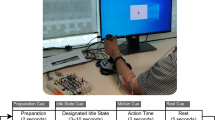Abstract
Exoskeletons offer great facilities to the elderly and disabled people with respect to extending their moving ranges and reacting to certain physical activities. Electromyogram (EMG) signals, which are derived from the neuromuscular system, provide an important access to the human-robot interface. On one hand, EMG signals can be used for real-time estimation of the motion intention of human body, e.g., the current joint angle status. On the other hand, however, the process of the mass EMG data, which are captured instantaneously from skin surface, challenges the state-of-the-art technology. Because its non-stationary and randomness, it is difficult to extract the valuable and stable features from the raw EMG signals. This paper investigates into the learning process of high dimensional EMG signals with a hierarchical mechanism that projects the original data into a lower feature space to achieve a local refined mapping from the EMG signals to the motion states of the human body. This hierarchically projected regression algorithm constructs incrementally a tree-based knowledge library, whose components represent local regression models. The components will be retrieved online efficiently and contribute to the estimation of the motion states. A great number of experiments are carried out to evaluate the accuracy of this novel algorithm.












Similar content being viewed by others
References
Bueno L, Brunetti F, Frizera A, Pons JL (2008) Chapter 4: Human–robot cognitive interaction. In: Pons JL (ed) Wearable robots: biomechatronic exoskeletons. John Wiley & Sons, England
Cavallaro EE, Rosen J, Perry JC, Burns S (2006) Real-time myoprocessors for a neural controlled powered exoskeleton arm. IEEE Trans Biomed Eng 53(11):2387–2396
Buchanan TS, Lloyd DG, Manal K, Besier TF (2004) Neuromusculoskeletal modeling: estimation of muscle forces and joint moments and movements from measurements of neural command. J Appl Biomech 20(4):367–395
Buchanan TS, Lloyd DG, Manal K, Besier TF (2005) Estimation of muscle forces and joint moments using a forward-inverse dynamics model. Med Sci Sports Exerc 37(11):1911–1916
Wang L, Buchanan TS (2002) Prediction of joint moments using a neural network model of muscle activations from EMG signals. IEEE Trans Neural Syst Rehabil Eng 10(1):30–37
Xu JX, Zhang Y, Pang YJ (2010) A nonlinear parametric identification method for biceps muscle model by using iterative learning approach. 2010 8th IEEE international conference on control and automation, pp 252–257
Bida O, Rancourt D, Clancy EA (2005) Electromyogram amplitude estimation and joint torque model performance. In: Proceedings of the IEEE 31st annual northeast bioengineering conference, pp 229–230
Kiguchi K, Rahman MH, Sasaki M, Teramoto K (2008) Development of a 3DOF mobile exoskeleton robot for human upper-limb motion assist. Rob Auton Syst 56(8):678–691
Sato M, Yagi E (2011) A study on power assist suit using pneumatic actuators based on calculated retaining torques for lift-up motion. In: Proceedings of the SICE annual conference, pp 628–632
Song Q, Sun B, Lei J, Gao Z, Yu Y, Liu M, Ge Y (2006) Prediction of human elbow torque from EMG using SVM based on AWR information acquisition platform. In: Proceedings of the 2006 IEEE international conference on information acquisition, pp 1274–1278
Gopura RARC, Kiguchi K (2008) A human forearm and wrist motion assist exoskeleton robot with EMG-based fuzzy-neuro control. In: Proceedings of the 2nd biennial IEEE/RAS-EMBS international conference on biomedical robotics and biomechatronics, pp 550–555
Rasmussen CE, Williams CKI (2006) Gaussian processes for machine learning, chapter 2. MIT Press, Cambridge, MA
Ting J, D’Souza A, Vijayakumar S, Schaal S (2010) Efficient learning and feature selection in high-dimensional regression. Neural Comput 22(4):831–886
Bu N, Okamoto M, Tsuji T (2009) A hybrid motion classification approach for EMG-based human-robot interfaces using Bayesian and neural networks. IEEE Trans Robot 25(3):502–511
Artemiadis PK, Kyriakopoulos KJ (2007) EMG-based position and force control of a robot arm: application to teleoperation and orthosis. In: Proceeding of IEEE/ASME international conference on advanced intelligent mechatronics, pp 1–6
McLachlan GJ, Peel D (2000) Finite mixture models. Wiley, New York
Bishop CM (2006) Pattern recognition and machine learning, chapter 4 and chapter 12. Springer Science + Business Media, New York
Ha KH, Varol HA, Goldfarb M (2011) Volitional control of a prosthetic knee using surface electromyography. IEEE Trans Biomed Eng 58(1):144–151
Weng J, Hwang W (2007) Incremental hierarchical discriminant regression. IEEE Trans Neural Netw 18(2):397–415
Acknowledgments
This work was supported in part by the National Natural Science Foundation of China under grant 61035005 and 61075087, Hubei Provincial Natural Science Foundation of China under grant 2010CDA005, Hubei Provincial Education Department Foundation of China under grant no. Q20111105, Natural Science Foundation of Liaoning Province. The authors owe many thanks to Qichuan Ding, Weiran Cao and Anbin Xiong for valuable discussions. Special thanks go to Cheng Chen who helps much about the experiments platform of this study.
Author information
Authors and Affiliations
Corresponding author
Rights and permissions
About this article
Cite this article
Chen, Y., Zhao, X. & Han, J. Hierarchical projection regression for online estimation of elbow joint angle using EMG signals. Neural Comput & Applic 23, 1129–1138 (2013). https://doi.org/10.1007/s00521-012-1045-8
Received:
Accepted:
Published:
Issue Date:
DOI: https://doi.org/10.1007/s00521-012-1045-8




